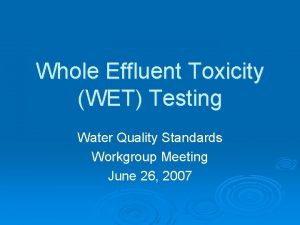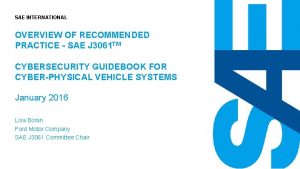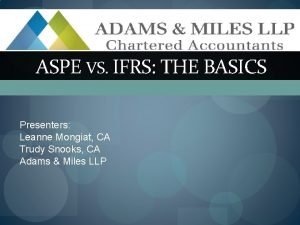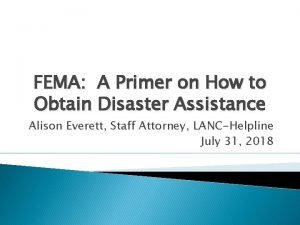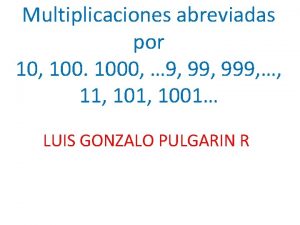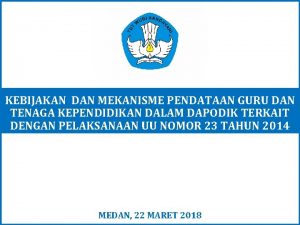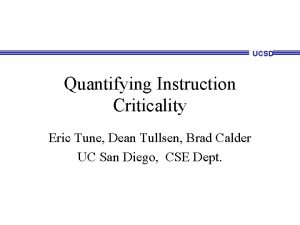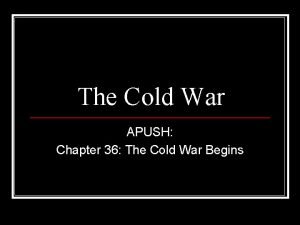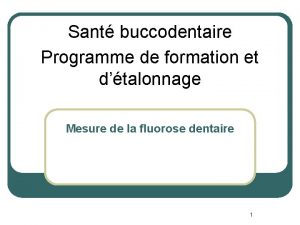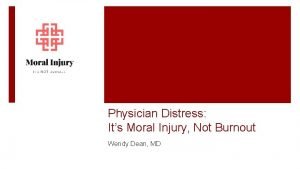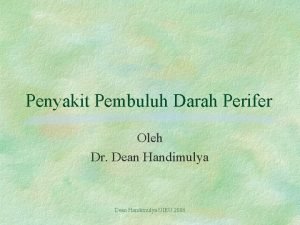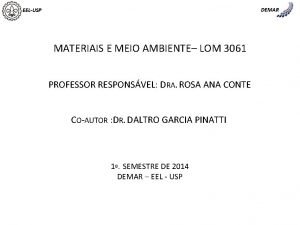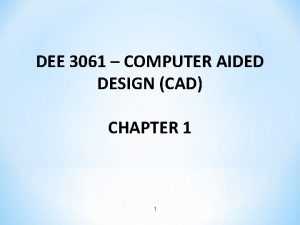PropertyEvidence Management Kolene Dean 817 999 3061 Retired








































































- Slides: 72

Property/Evidence Management Kolene Dean 817 -999 -3061 Retired 2003 over 27 yrs. Hurst Police Department Over 35 years experience Past President Texas Division International Association Identification 1985 -86 Founder and Past President Texas Association Property & Evidence Inventory Technicians (T. A. P. E. I. T. ) 1997 -2002

Goal Today is to keep you out of the Headlines Help you understand the importance of the property room Expose you to what is available to your Department How to Manage a Property/Evidence Room

Chain of Custody • Black’s Law Dictionary defines Chain of Custody as: • In, evidence, the one who offers real evidence, such as narcotics in a trial of a drug case. Must account for the custody of the evidence from the moment in which it reaches his custody until the moment in which it is offered in evidence, and such evidence goes to weight not admissibility of evidence.

Chain of Custody • The care custody and control of evidence from its birth at the scene of the crime until its death at disposal. Maintaining the records at a minimum of 3 years.

Do we have a problem?

SOP • Departmental SOP and a Property Room Procedural Manual • Daily, Monthly, Semi-Annually, Annually for the property/evidence room • There is more to it than just receiving and placing on a shelf. If we don’t purge then the issue is SPACE

• What works for one Department may not always work for another. • Why do we handle property/evidence the way we do? • Where do we get rid of all the STUFF? • This is why we must have standards and training keeping everyone up to date on the how, when and where. • Handling property/evidence in the right manner will help in relieving the cities or counties of liabilities.

Some Departments Rats Eat the Marijuana

HOW ARE YOU DOING? • How much of your evidence goes to court? • How old is your evidence? • Do you have a procedure manual for the property section? • Does your department require an inventory at least once a year or with personnel changes? • Do you require an audit at least once a year? • Do you separate the 3 critical areas in a property room?

• Do you restrict access to the property room? • Are locks changed or codes removed when personnel changes? • Do you have a right of refusal? • Do you have packaging guidelines? • Does policy forbid property personnel from making the decision about disposal and/or release of evidence? • Do you have a purging or review procedure? • Does your department utilize civilians in the property room?

Secure Areas • Sign in and out logs • Locks (Interchangeable Core Lock) An interchangeable core or ic is a compact keying mechanism in a specific "small format" figure-eight shape. Unlike a standard key cylinder, which is accessible for combining only via locking device disassembly, an interchangeable mechanism relies upon a specialized "control" key for insertion and extraction of the essential (aka "core") combining components. . .

Packaging

Paper • Plastic Boxes

• PACKAGING AND LABELING PROPERTY PRIOR TO STORAGE Proper packaging of evidence is essential for trial purposes. The concept of packaging is to maintain evidentiary value. Property and evidence that is to be logged in will be described on a voucher Only one item or “ like items” such as bullets, prints, etc. per compartment or bag. Each compartment should be marked numerically and those same numbers correspond with the numbers on the voucher. The voucher should be descriptive (make, model, serial number, color, qty, wt, etc. ) The submitting officer’s initials and date should be placed over each sealed edge.

In addition, the case number should be written clearly on each compartment or bag with a permanent marker. Seals should be double sealed in the event one of the items needs to be sent to the lab or checked out. This prevents cutting the seal to the next compartment. In some instances, property will need to be bagged into paper bags. As plastic does not breathe, organic evidence such as shoes or clothing that contains any amount of moisture, may create condensation, decay and destruction of the evidence. In addition to organic materials, latent fingerprints on firearms or other items may also be destroyed if condensation is present in the evidence bag. In these cases, it is necessary to thoroughly dry the evidence before packaging and preferable to use porous evidence storage containers such as paper or cardboard. The bags should be marked in the same way as the plastic bags and each item bagged individually. Use evidence tape for sealing.

All property needs to be bagged unless too large. Large items (each one) need to be tagged and marked with case number, item number, date, and officers initials. If you do use some other packaging container, such as paper bags or boxes, items shall be packaged in the smallest acceptable container. All license plate submittals shall have the registration from MVD attached. Occasionally, property or evidence needs to be checked out for investigations, court, or printing etc. The evidence checked out will need to be signed out by the requesting officer and it’s purpose for doing so. Upon return of the property or evidence it must be returned packaged and sealed. The officer shall put his initials and date over the new seal. Any evidence needing to be submitted to the lab for analysis must have it indicated in the notes on the voucher. If the item is currency, the currency sheet will need to be filled out and signed by both officers and submitted with the voucher. However, the currency sheet does require two people to verify the amounts and signed by the submitting officer as well as the witnessing officer. Both officer’s initials and date will be placed on the seals of the evidence bag(s). A comment line is provided on the sheet to note any directions you may have regarding any property you submit.

• GUIDELINES Every item of property obtained by an employee during a shift should be placed under the control of the property and evidence function prior to shift’s end. This should allow the property to be officially recorded in the agency’s records in a timely manner. Any exception to this procedure must have supervisor approval and a descriptive inventory must be accomplished in writing or by electronic means and a copy forwarded to the Property Coordinator. The employee shall prepare a report or supplement describing how, what, when, where, he or she came into possession of the property and a physical description of the property itself including quantity and weight and length of knife blade if applicable as well as a descriptive propertyevidence voucher.

All officers shall carefully scrutinize all items of evidence to determine their evidentiary value. Items with no apparent value should not be seized. If an item is needed for investigative purposes, only then should it be retained. Evidence connected to theft cases may be photographed and released. If property is recovered that belongs to another jurisdiction it may be released to that jurisdiction at that time. When using print powder in the prep room, make sure and have newspaper down. The powder gets into the pores of the plastic and the powder then gets on everything and everyone. You must still wash down counter tops even after using the newspaper as somehow it still manages to get into the plastic. Print powder and other residues can ruin someone else’s evidence and/or clothes. After processing your evidence, please put up your supplies and clean the work area.

PACKAGING AND STORAGE PROCEDURES Plastic Bag Storage 1. What to store in plastic a. Electronics b. Paper c. Jewelry d. Narcotics e. Dried Marijuana f. Drug Paraphernalia What not to store in plastic a. Biological Evidence b. Wet marijuana c. Wet blood stained items

Paper Bag Storage What to store in paper a. Wet blood stained items b. Evidence to be printed or glued c. Evidence that may contain DNA d. VHS tapes DNA Evidence 1. Store in cool, dry area 2. No sunlight exposure 3. Refrigerate sexual assault kits / biological samples 4. Freeze Tissue samples

Packaging Procedures 1. Plastic a. Sealed / Initialed 2. Paper Sacks a. Sealed / Initialed 3. Drugs / Narcotics a. Packaged Separately b. Weight c. Count Pills 4. Weapons (Guns, Rifles, Knifes) a. Boxed b. Sharp containers

5. Jewelry a. Package Separate b. color 6. Sexual Assault Kits a. Separate b. Never Combine Items c. No Sunlight 7. Currency a. Separate b. Denominations c. Second count / Signatures 8. VHS Tapes / CD Discs (Do Not Mark with MARKS-A-LOT) 9. Photo’s

• Caution • Know what you are dealing with • Air Purification System • Protective Clothing • Washing Hands (22 seconds)

EPA: Environmental Protection Agency American Lung Association AAAAI: American Academy of Allergy Asthma & Immunology AANMA: Allergy & Asthma Network Mothers of Asthmatics OSHA: US Department of Labor National Safety Council Environmental Health Center ASHRAE: American Society of Heating, Refrigerating and Air-Conditioning Engineers, Inc. ACCA: Air Conditioning Contractors of America ARI: Air Conditioning & Refrigeration Institute NADCA: National Air Duct Cleaners Association NAFA: National Air Filtration Association

BLOOD BORNE PATHOGENS • AIDS virus will die in 2 to 6 hours • • • HEPATITIS NEVER DIES HEPATITIS SHOTS TITER TEST FOR VERIFICATION TUBERCULOSIS 10% BLEACH WATER

DNA EVIDENCE • Any piece of evidence may have DNA possibilities • Freeze ? ? • If you receive it wet • Store it wet • If received dry • Store dry. • Always package appropriately

DRUGS KD 030711 • Plastic must be 4 mil thick or thicker • Accurate counts & weights • Sealed Dated & Initialed by submitting officer • Date Received & Initialed by YOU • Restricted Access • Court Orders or Written Procedures • Health & Safety Code

ASPERGILLUS • Marihuana white mold • Compost Bends • Google It Aspergillosis is disease cause by Aspergillus. There are many different kinds of aspergillosis. One kind is allergic bronchopulmonary aspergillosis (also called ABPA), a condition where the fungus causes allergic respiratory symptoms, such as wheezing and coughing, but does not actually invade and destroy tissue. Another kind of aspergillosis is invasive aspergillosis, a disease that usually affects people with immune system problems. In this condition, the fungus invades and damages tissues in the body. Invasive aspergillosis most commonly affects the lungs, but can also cause infection in many other organs and can spread throughout the body. www. cdc. gov Center for Disease

ASPERGILLUS Part 1: What Is Aspergillus? By Nancy E. Master

What Is An Audit An audit of the Property & Evidence room is an impartial review of the policies, procedures, and actions of an operation to determine whether or not they meet the recognized standards and the agency’s own policies.

What are the benefits of having an Audit be done periodically by an outside person or agency? An external audit performed by non-employees of the agency avoids internal politics and provides a level of independence that cannot be obtained from an internal audit.

An inside audit should be done by what department within the agency? An internal audit should be conducted by a person(s) or unit that does not have responsibilities within the evidence operation.

What is an Inventory of the Property and Evidence Section? An inventory of the Property and Evidence section will provide accountability of all items submitted to the care, custody and control of the department.

Will an Inventory of the Property Room help in the purging process? Yes, you will locate items that the Statute of Limitations has expired or the item has been missing.

Dispositions • Hold until Statute of Limitations Runs if no defendant. • Receive something from the Court • Research your case know how many defendants were filed on • NEVER DISPOSE OF ANY EVIDENCE UNTIL ALL CASES HAVE BEEN DISPOSED

How to Work • Verify Case Numbers • Names of Defendants (caution # of defendants) • Verify Charges • Place Date & Disposition in your files • Send to Investigator Assigned for verification • Follow Departmental Procedures for disposal or release

Have we learned anything today? Does organization work?

Does Organization Work?



CODE OF CRIMINAL PROCEDURE CHAPTER 12. LIMITATION • STATUTE OF LIMITATION • Statute - law established by a legislative body • Limitation - an imposed restriction that cannot be exceeded or sidestepped

Guidelines q UNKNOWN DEFENDANT CHARGES HAVE NOT BEEN FILED THROUGH THE APPROPRIATE COURT Chapter 12 CCP q

Quick Guide to chp. 12 � Murder, Manslaughter, Sexual Assault, � Accident ----------------------ITEMS CONTAINING DNA �No Limitation � Theft, Forgery, Injury Elderly or Disabled, Sexual Assault, Arson -------------------� False Statement (to obtain property, credit)money Laundering; credit card or debit card abuse -------------------� Theft or Robbery, Kidnapping or Burglary, Injury to an Elderly or Disabled, Abandoning or Endangering a Child, Insurance fraud ----------------------� All Other Felonies ----------------------� Misdemeanors � 10 Years 40 years � 7 Years � 5 Years � 3 Years � 2 Years

Art. 18. 17. DISPOSITION OF ABANDONED OR UNCLAIMED PROPERTY. Guidelines 18. 17 Under $500. 00 • Owner Known • Owner Unknown • Unclaimed for 30 days then • Certified Letter 90 Days to Claim item may be sold, donated or forfeited for departmental use • Suggest Court Order forfeiting for departmental use • If unclaimed items may be sold, donated or forfeited for department use

Guideline over $500. 00 Owner Unknown • $500 or more shall be preceded by a notice published once at least 14 days prior to the date of such sale in a newspaper.

Art. 18. DISPOSITION OF GAMBLING PARAPHERNALIA, PROHIBITED WEAPON, CRIMINAL INSTRUMENT, AND OTHER CONTRABAND • court entering the judgment of conviction shall order that the machine, device, gambling equipment or gambling paraphernalia, instrument, obscene device or material, child pornography, or scanning device or re-encoder be destroyed or forfeited to the state. ******* • If there is no prosecution or conviction following seizure, the magistrate to whom the return was made shall notify in writing the person found in possession of the alleged ****** • equipment to show cause why the property seized should not be destroyed or the proceeds forfeited. ****

• The magistrate, on the motion of the law enforcement agency seizing a prohibited weapon, shall order the weapon destroyed or forfeited to the law enforcement agency seizing the weapon, unless a person shows cause as to why the prohibited weapon should not be destroyed or forfeited.

Criminal Instrument • For purposes of this article: • (1) "CRIMINAL INSTRUMENT" has the meaning defined in the Penal Code; 46. 00(b) For the purpose of this section, "criminal instrument" means anything, the possession, manufacture, or sale of which is not otherwise an offense, that is specially designed, made, or adapted for use in the commission of an offense. • (2) "gambling device or equipment, altered gambling equipment or gambling paraphernalia" has the meaning defined in the Penal Code; • (4) "dog-fighting equipment" means:

(3) "prohibited weapon" has the meaning defined in the Penal Code; Sec. 46. 05. PROHIBITED WEAPONS . – (a) A person commits an offense if he intentionally or knowingly possesses, manufactures, transports, repairs, or sells: – (1) an explosive weapon; – (2) a machine gun; – (3) a short-barrel firearm; – (4) a firearm silencer; – (5) a switchblade knife; – (6) knuckles; – (7) armor-piercing ammunition; – (8) a chemical dispensing device; or – (9) a zip gun.

Art. 18. 19. DISPOSITION OF SEIZED WEAPONS . • (a) Weapons seized in connection with an offense involving the use of a weapon or an offense under Penal Code Chapter 46 shall be held by the law enforcement agency making the seizure, subject to the following provisions, unless: ***** • c) If there is no prosecution or conviction for an offense involving the weapon seized, the magistrate to whom the seizure was reported shall, before the 61 st day after the date the magistrate determines that there will be no prosecution or conviction, notify in writing the person found in possession of the weapon that the person is entitled to the weapon upon written request to the magistrate.

� The magistrate shall order the weapon returned to the person found in possession before the 61 st day after the date the magistrate receives a request from the person. *** � If the weapon is not requested before the 61 st day after the date of notification, the magistrate shall, before the 121 st day after the date of notification, order the weapon destroyed or forfeited to the state for use by the law enforcement agency holding the weapon or by a county forensic laboratory designated by the magistrate. *** If the magistrate does not order the return, destruction, or forfeiture of the weapon within the applicable period prescribed by this subsection, the law enforcement agency holding the weapon may request an order of destruction or forfeiture of the weapon from the magistrate.

(d) A person either convicted or receiving deferred adjudication under Chapter 46, Penal Code, is entitled to the weapon seized upon request to the court in which the person was convicted or placed on deferred adjudication. However, the court entering the judgment shall order the weapon destroyed or forfeited to the state for use by the law enforcement agency holding the weapon or by a county forensic laboratory designated by the court if: (1) the person does not request the weapon before the 61 st day after the date of the judgment of conviction or the order placing the person on deferred adjudication;

Guideline 18. 19 • (c) NO PROSECUTION OR CONVICTION • WEAPON NOT REQUESTED 61 ST MAGISTRATE • Property Hearing within 61 days before 121 st weapon destroyed, forfeited department, forensic laboratory by a magistrate

Art. 38. 43. EVIDENCE CONTAINING BIOLOGICAL MATERIAL • any item that contains blood, semen, hair, saliva, skin tissue, fingernail scrapings, bone, bodily fluids, or any other identifiable biological material that was collected as part of an investigation of an alleged felony offense** • An entity or individual described by Subsection (b) shall ensure that biological evidence collected pursuant to an investigation or prosecution of a felony offense or conduct constituting a felony offense is retained and preserved: ****

(1) for not less than 40 years, or until the applicable statute of limitations has expired, if there is an apprehended actor associated with the offense; or or(2) until the defendant dies, completes the defendant's sentence, or is released on parole or mandatory supervision, if the defendant is sentenced to a term of confinement or imprisonment. **** (d) The attorney representing the state, clerk, or other officer in possession of biological evidence described by Subsection (a) may destroy the evidence, but only if the attorney, clerk, or officer by mail notifies the defendant, the last attorney of record for the defendant, and the convicting court of the decision to destroy the evidence and a written objection is not received by the attorney, clerk, or officer from the defendant, attorney of record, or court before the 91 st day after the later of the following dates: (e) To the extent of any conflict, this article controls over Article 2. 21.

Guidelines • 40 years or statute • possession of the state during the prosecution of the case • time of conviction was known to contain biological material that if subjected to scientific testing would more likely than not • establish the identity of defendant • exclude a person • Hold until the inmate is executed, dies, or is released on parole, if the defendant was convicted of a capital felony; or • until the defendant dies, completes the defendant's sentence, or is released on parole or mandatory supervision, if the defendant is sentenced to a term of confinement or imprisonment

• SECTION 2. Section 420. 003, Government Code, is amended by amending Subdivisions (1) and (6) and adding Subdivisions (1 -a), (1 -b), (1 -c), and (1 -d) to read as follows: • (1) "Accredited crime laboratory" means a crime laboratory, as that term is defined by Article 38. 35, Code of Criminal Procedure, that has been accredited under 411. 0205. • SECTION 3. Subsection (e), Section 420. 031, Government Code, is amended to read as follows: • (e) Evidence collected under this section may not be released unless a signed, [the survivor of the offense or a legal representative of the survivor signs a] written consent to release the evidence is obtained as provided by Section 420. 0735.

Section Sec. 420. 033. CHAIN OF CUSTODY. Medical, law enforcement, department, and laboratory personnel who handle sexual assault evidence under this chapter or other law shall maintain the chain of custody of the evidence from the time the evidence is collected until the time the evidence is destroyed. Sec. 420. 042. ANALYSIS OF SEXUAL ASSAULT EVIDENCE. (a) A law enforcement agency that receives sexual assault evidence collected under this chapter or other law shall submit that evidence to a public accredited crime laboratory for analysis not later than the 30 th day after the date on which that evidence was received. (b) A person who submits sexual assault evidence to a public accredited crime laboratory under this chapter or other law shall provide the following signed, written certification with each submission: "This evidence is being submitted by (name of person making submission) in connection with a criminal investigation. "

Sec. 420. 0735. CONSENT FOR RELEASE OF CERTAIN EVIDENCE. (a) Consent for the release of evidence contained in an evidence collection kit must be in writing and signed by: (1) the survivor, if the survivor is 14 years of age or older; (2) the survivor's parent or guardian or an employee of the Department of Family and Protective Services, if the survivor is younger than 14 years of age; or GET COURT or DISTRICT ATTORNEYS APPROVAL (c) Consent for release under Subsection (a) applies only to evidence contained in an evidence collection kit and does not affect the confidentiality of any other confidential information under this chapter. (d) The written consent must specify: (1) the evidence covered by the release; (2) the reason or purpose for the release; and (3) the person to whom the evidence is to be released.

Art. 38. 34. PHOTOGRAPHIC EVIDENCE IN THEFT CASES The photograph is as admissible in evidence as is the property itself CHAPTER 47. DISPOSITION OF STOLEN PROPERTY only if the ownership of the property is contested or disputed. 47. 01 a. RESTORATION WHEN NO TRIAL IS PENDING. hold a hearing to determine the right to possession of the property, upon the petition of an interested person, a county, a city, or the state. CHAPTER 59. FORFEITURE OF CONTRABAND Chapter 64 Motion forensic DNA Testing

Health & Safety Code Sec. 481. 151. DEFINITIONS (3) "Summary destruction" or "summarily destroy" means destruction without the necessity of any court action, a court order, or further proceedings. 481. 153. SEIZURE, SUMMARY FORFEITURE, AND SUMMARY DESTRUCTION OF CONTROLLED SUBSTANCE PROPERTY Section 481. 159, or the department or a peace officer may summarily destroy the property under the rules of the department.

Sec. 481. 154. RULES • . (a) The director may adopt reasonable rules and procedures, not inconsistent with the provisions of this chapter, concerning: • (1) summary forfeiture and summary destruction of controlled substance property or plants; • (2) establishment and operation of a secure storage area; • (3) delegation by a law enforcement agency head of the authority to access a secure storage area; and • (4) minimum tolerance for and the circumstances of loss or destruction during an investigation.

• (b) THE RULES FOR THE DESTRUCTION OF CONTROLLED SUBSTANCE PROPERTY OR PLANTS MUST REQUIRE: • (1) more than one person to witness the destruction of the property or plants; • (2) the preparation of an inventory of the property or plants destroyed; and • (3) the preparation of a statement that contains the names of the persons who witness the destruction and the details of the destruction. • (c) A document prepared under a rule adopted under this section must be completed, retained, and made available for inspection by the director.

Alcohol Beverage Code 103. SEIZURE OF ILLICIT BEVERAGES • 103. 06. BEVERAGE DELIVERED TO COMMISSION. Any alcoholic beverage, its container, and its packaging which has been seized by a peace officer, as provided in • Section 103. 03 of this code, may not be replevied and shall be delivered to the commission for immediate public or private sale in the manner the commission considers best.

Texas Administrative Code • • TITLE 37 PUBLIC SAFETY AND CORRECTIONS PART 1 TEXAS DEPARTMENT OF PUBLIC SAFETY CHAPTER 13 CONTROLLED SUBSTANCES SUBCHAPTER G FORFEITURE AND DESTRUCTION • subchapter must strictly follow each SOP. A written SOP may exceed a minimum requirement contained within this subchapter. • (c) Generally. In order to minimize the likelihood of pilferage or other unlawful diversion, an SOP must include requirements that are reasonably likely to: • (1) uncover the occurrence of a discrepancy, loss, theft, or other potential diversion; and • (2) identify and destroy the excess quantity of an item, in order to reduce the size of an exhibit while preserving its evidentiary value. • (d) Modify definition of "excess quantity. " With the express approval of each appropriate prosecuting authority, an SOP may increase or decrease the amount of an item necessary to meet the definition of an "excess quantity" under that SOP. • (e) Specifically. An SOP must include a requirement that:

RULE § 13. 158 Manner of Destruction - Security Control • (a) Destruction by anyone. A person may accomplish routine destruction of an item under this subchapter by burning in a suitable incinerator or by another method as long as the person performs the destruction in: • (1) a safe and responsible manner; • (2) compliance with all relevant federal, state, and local laws; and • (3) compliance with all requirements of the Texas Commission on Environmental Quality and the EPA. • (b) Private contract. If a laboratory, law enforcement agency, or peace officer contracts with a private entity to destroy the item, the private contractor must:

• (2) obtain full permitting from the EPA as a hazardous waste transportation, storage, or disposal facility, as appropriate. • (1) hold a controlled substances registration number from the director and DEA; and • (c) Destruction by officer. The director recommends but does not require that an individual peace officer should not destroy hazardous material, unless that officer possesses the special expertise required to handle the material safely and lawfully.

RULE § 13. 156 Destruction Authority - Court Order • (a) Statutory authority. A court may issue an order of destruction for an item that: • (1) is controlled substance property or plant under the authority of the Act, § 481. 159; or • (2) was stolen or acquired in any other manner that made the acquisition a penal offense under the authority of the Texas Code of Criminal Procedure, Chapter 47. • (b) Security provisions required by the court. A laboratory, law enforcement agency, or peace officer carrying out a court order of destruction must comply with the documentation and security provisions of the order, if any. • (c) No security provisions required by the court. If the court order is silent about the manner of destruction, or if it does not specify or direct another manner of destruction inconsistent with this subchapter, the laboratory, law enforcement agency, or peace officer must comply with the documentation and security provisions of this subchapter.

Appeals in Capital Case Art. 44. 251 CCP • Art. 44. 251. REFORMATION OF SENTENCE IN CAPITAL CASE. (a) The court of criminal appeals shall reform a sentence of death to a sentence of confinement in the institutional division of the Texas Department of Criminal Justice for life without parole if the court finds that there is legally insufficient evidence to support an affirmative answer to an issue submitted to the jury under Section 2(b), Article 37. 071. • (b) The court of criminal appeals shall reform a sentence of death to a sentence of confinement in the institutional division of the Texas Department of Criminal Justice for life without parole if: (1) the court finds reversible error that affects the punishment stage of the trial other than a finding of insufficient evidence under Subsection (a) of this article; and • • • (2) within 30 days after the date on which the opinion is handed down, the date the court disposes of a timely request for rehearing, or the date that the United States Supreme Court disposes of a timely filed petition for writ of certiorari, whichever date is later, the prosecuting attorney files a motion requesting that the sentence be reformed to confinement for life without parole. (c) If the court of criminal appeals finds reversible error that affects the punishment stage of the trial only, as described by Subsection (b) of this article, and the prosecuting attorney does not file a motion for reformation of sentence in the period described by that subsection, the defendant shall receive a new sentencing trial in the manner required by Article 44. 29(c) of this code

• APPEALSArt. 44. 45. REVIEW BY COURT OF CRIMINAL APPEALS. (a) The Court of Criminal Appeals may review decisions of the court of appeals on its own motion. • An order for review must be filed before the decision of the court of appeals becomes final as determined by • Article 42. 045. (b) The Court of Criminal Appeals may review decisions of the court of appeals upon a petition for review. • (1) The state or a defendant in a case may petition the Court of Criminal Appeals for review of the decision of a court of appeals in that case. • (2) The petition shall be filed with the clerk of the court of appeals which rendered the decision within 30 days after the final ruling of the court of appeals. • (3) The petition for review shall be addressed to "The Court of Criminal Appeals of Texas, " and shall state the name of the petitioning party and shall include a statement of the case and authorities and arguments in support of each ground for review.

• (4) Upon filing a petition for review, the petitioning party shall cause a true copy to be delivered to the attorney representing the opposing party. The opposing party may file a reply to the petition with the Court of Criminal Appeals within 30 days after receipt of the petition from the petitioning party. • (5) Within 15 days after the filing of a petition for review, the clerk of the court of appeals shall note the filing on the record and forward the petition together with the original record and the opinion of the court of appeals to the Court of Criminal Appeals. • (6) The Court of Criminal Appeals shall either grant the petition and review the case or refuse the petition.

• (7) Subsequent to granting the petition for review, the Court of Criminal Appeals may reconsider, set aside the order granting the petition, and refuse the petition as though the petition had never been granted. • (c) The Court of Criminal Appeals may promulgate rules pursuant to this article. • (d) Extensions of time for meeting the limits prescribed in Subdivisions • (2) and (4) of Subsection • (b) of this article may be granted by the Court of Criminal Appeals or a judge thereof for good cause shown on timely application to the Court of Criminal Appeals.
 šátkový obvaz
šátkový obvaz Genu valgum deformity
Genu valgum deformity Dean d dean
Dean d dean Sae j3101
Sae j3101 Sae recommended practice
Sae recommended practice Aspe ifrs
Aspe ifrs Single premium endowment plan 817
Single premium endowment plan 817 1-817-868-2300
1-817-868-2300 Ct dot form 817
Ct dot form 817 Sprat qrp
Sprat qrp Day 1 day 2 day 817
Day 1 day 2 day 817 Berechs
Berechs La retired teachers association
La retired teachers association Post retirement medical scheme of indian oil
Post retirement medical scheme of indian oil One characteristic of plant assets is that they are:
One characteristic of plant assets is that they are: Fsu dean of students case management
Fsu dean of students case management Elements in period 2
Elements in period 2 Vre redesim
Vre redesim 999 or
999 or Mejor resolucion
Mejor resolucion 999 pencereli cami
999 pencereli cami Rx 999
Rx 999 15/999 mass street periodic table, o 8
15/999 mass street periodic table, o 8 999 data
999 data Ncp 999
Ncp 999 Successor in maths
Successor in maths Introduction copy and paste
Introduction copy and paste Elektroda srebrna 999
Elektroda srebrna 999 Multiplicacion abreviada para niños
Multiplicacion abreviada para niños 999 brubaker drive kettering ohio
999 brubaker drive kettering ohio Indonesia kekurangan guru
Indonesia kekurangan guru 999 ems research forum
999 ems research forum 36 1 999
36 1 999 Walter dean myers
Walter dean myers Vance jennings
Vance jennings Bad boy walter dean myers summary
Bad boy walter dean myers summary Bad boy walter dean myers summary
Bad boy walter dean myers summary Dean tullsen ucsd
Dean tullsen ucsd Ch 36 apush
Ch 36 apush Now allison dean
Now allison dean Sgs upm
Sgs upm Revelation song phillips craig and dean video
Revelation song phillips craig and dean video Jeff dean google scholar
Jeff dean google scholar Nancy dean
Nancy dean Monster walter dean myers vocabulary
Monster walter dean myers vocabulary Monster walter dean myers vocabulary
Monster walter dean myers vocabulary Jessica dean attorney
Jessica dean attorney Janet dean fodor
Janet dean fodor Matthew dean dmu
Matthew dean dmu Mark dean awards
Mark dean awards Dean cock
Dean cock Rascoe dean
Rascoe dean Dean mistura
Dean mistura Sandeep gopalan
Sandeep gopalan Hypercrinia
Hypercrinia Dean djokic
Dean djokic Dean djokic
Dean djokic Dean dixonův test
Dean dixonův test Uva math placement
Uva math placement Medical faculty in novi sad dean
Medical faculty in novi sad dean Mr irwin lasher
Mr irwin lasher What's the theme of lemon brown
What's the theme of lemon brown The treasure of lemon brown
The treasure of lemon brown Indice de dean
Indice de dean Richard dean anderson hockey
Richard dean anderson hockey Restaurant programs of america
Restaurant programs of america Cronies calorie restriction
Cronies calorie restriction Wendy dean moral injury
Wendy dean moral injury Dr dean handimulya
Dr dean handimulya Is berlo's model of communication transactional
Is berlo's model of communication transactional Dean neikirk
Dean neikirk Danine dean
Danine dean Editha william dean howells
Editha william dean howells


